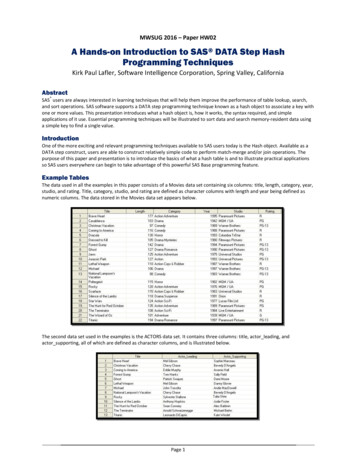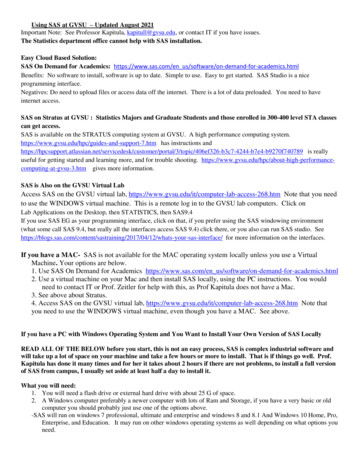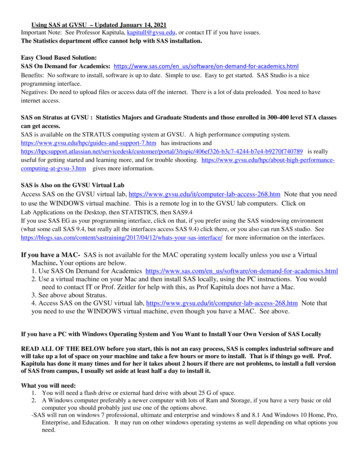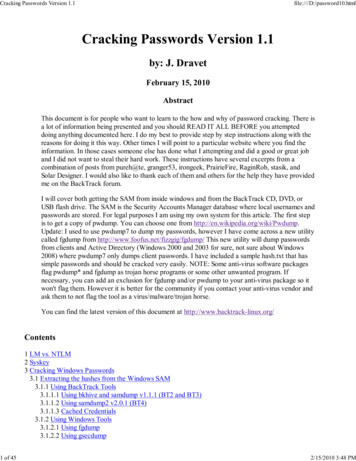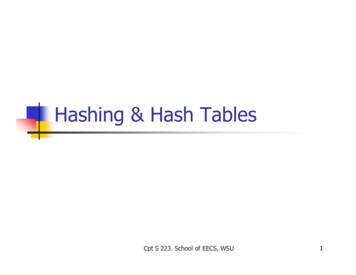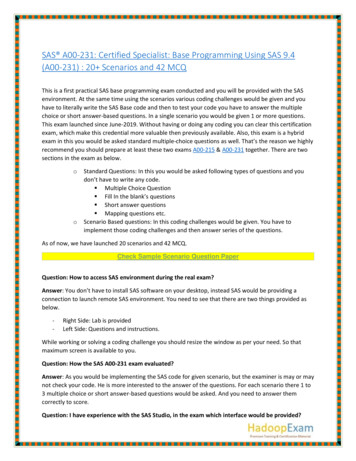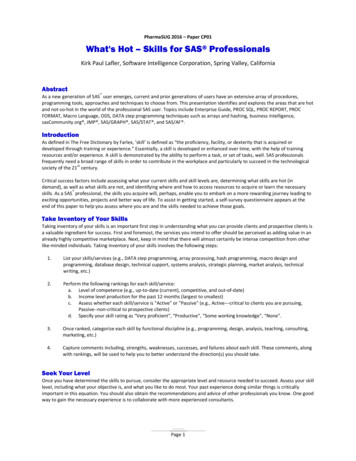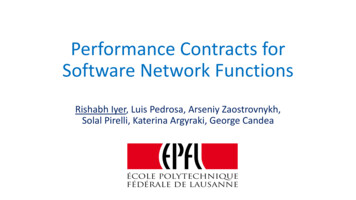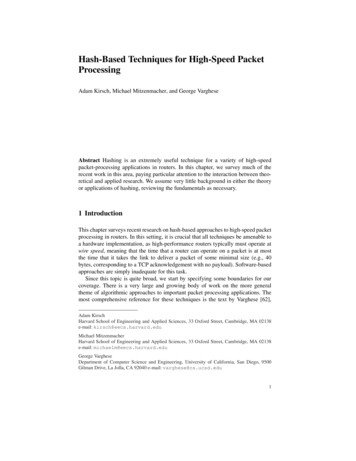
Transcription
SCSUG 2012SAS HASH Programming basicsDaniel Sakya, PPD Inc., Austin, TXAbstractHASH programming is a hot topic in the industry that started with SAS 9. This paper is intended toprovide more exposure to novice or experienced SAS programmers that are looking for alternatives todata step programming. The concept of HASH programming is similar to the definition of an array in SAS.Several SAS users have benefitted from HASH programming by considerably reducing the processingtime for compound data merging tasks. This paper will entail the introduction to HASH programming, itssyntax, a few examples, and last but not least, the benefits on using HASH programming versus regulardata step. The examples and syntax illustrated are in SAS 9.2.IntroductionData step programming is the cornerstone of SAS programming. However, when dealing with largevolumes of data, it data step programming can be cumbersome and slow. This is where hashprogramming can become advantageous to provide safe, efficient, and straightforward tool for datamanipulations including creating and accessing datasets.Just like the concept of array, hash programming accesses the memory index tables for faster access todata. However, unlike arrays, using hash programming does not need sequential integers to access thedata – it can be done via characters or numbers. Also, the data does not need to be sorted – one of thebest‐selling points.Hash programming has increasingly become a hot topic that has piqued the interest of many SASprogrammers, including yours truly, and continues to become a growing trend in the industry that canbe a very useful alternative to data step programming. We will explore the syntax for hash programmingin this paper with some examples to pique users’ interests into using this object oriented approach inSAS.SyntaxTo declare a hash object, you use the DECLARE statement. The statement will let SAS know that thereferenced object is a hash object.declare hash x;
After a hash object has been declared, it needs to be initialized. This can be done via the NEWoperator:x NEW hash( );The above line of code creates and initializes the hash object x after it has been declared.The above two statements can be condensed into one line with the following statement:Declare hash X( );SAS dataset options can also be used while declaring and defining hash objects but it is limited to thefollowing operations: RenameWhereDrop or KeepOutput statement can be used in to specify an output datasetSubset observations based on observation numberThe rename operation is used in the following example:declare hash X(dataset: ‘table (rename (CPEVENT VISIT) ) );
ExamplesThe followwing examplee declares andd initializes thhe hash objecct. After the ddeclaration, thhe key and daataobjects arre defined, affter which, values are addeed to the key and data objjects.The abovee example deefines has the hash object “eg” and assoociates the keey object as ““patient” and dataobject as “trtgrp”. The DefineDone statement lets SAS know tthat all definiitions for the hash objectss arenow compplete. The add statementss add data to the key and ddata variabless within the hhash objects.Once the key and data variables havve been definned, they can be accessed via the find sstatement.The abovee code will ouutput the folloowing:trrtrgrp Treatmment conc. BSAS log reesults:
Multiple datador key obbjects can be added to thee hash object s by separatinng the variabbles by a commma.For exampple, in the above illustratioon, multiple datadvariabless can be definned with the ffollowingstatement:x ndt’);The abovee statement addsa“trtgrp”,, “trtstdt”, annd “trtendt” t o the “eg” haash object.To add daata to the data objects, thee following statement can be used:x eg.add(keyy: ‘X1’, data: ‘CControl’, dataa: ’13FEB20122’, data: ’21MMAR2012’);So why useu hash proogramming?The abovee syntax and examples maay look a bit complex and sscary enough to make youu wonder whyy youshould evven bother with hash progrramming. However, there are various bbenefits of haash programmming: Effficient and faast use of thee virtual memory which ca n prove very useful when merging multipledatasets with largelnumberr of records.WhenWmergingg multiple dattasets, they don’tdneed to be sorted as long as keys are properlydefined.c return muultiple items unlikeuarray oobjects that caan only return one value.Hash objects can
Typically, hash objects do the programming tasks faster than traditional data step or SQLprogramming (depending on the data, the available memory, your environment, etc.)Hash objects are also very good for data summarization and can typically execute the job up totwice as fast while utilizing a third of the memory when compared with data step programming.ConclusionSAS hash programming is a powerful and efficient object oriented approach for table lookups, merges,data summarization, and sorting purposes. I encourage users to perform and compare data step mergesversus hash merges in terms of compilation and execution time. Users will notice that even though itmay seem a bit complicated at first, they will write less lines of code and perform faster executions oftheir programs. There are numerous resources and papers out there that talk about efficiency inexecution and provide more details to this wonderful memory based object oriented approach thatevery SAS user should be familiar with.ReferencesHash objects – Why bother?Barb oads/presentations/HUG09/Hash.pdfAn Introduction to SAS Hash Programming TechniquesKirk Paul amming%20Techniques.pdfI cut my processing time by 90% using hash tables ‐ You can do it too!Jennifer K. nesug07/bb/bb16.pdfAcknowledgementsI would like to thank SCSUG 2012 for accepting my abstract and giving me the opportunity to presentthis paper to the audience as well as Jeanina Worden and PPD for the encouragement to proceed withmy first paper.
Contact informationAny comments or suggestions are greatly appreciated and can be sent to:Daniel SakyaSenior Programmer AnalystPPD Inc.7551 Metro Center Dr. Suite 300Austin, TX 78744(512) 747‐5205Daniel.sakya@ppdi.com
This paper will entail the introduction to HASH programming, its syntax, a few examples, and last but not least, the benefits on using HASH programming versus regular data step. The examples and syntax illustrated are in SAS 9.2. Introduction Data step programming is the cornerstone of SAS programming.
